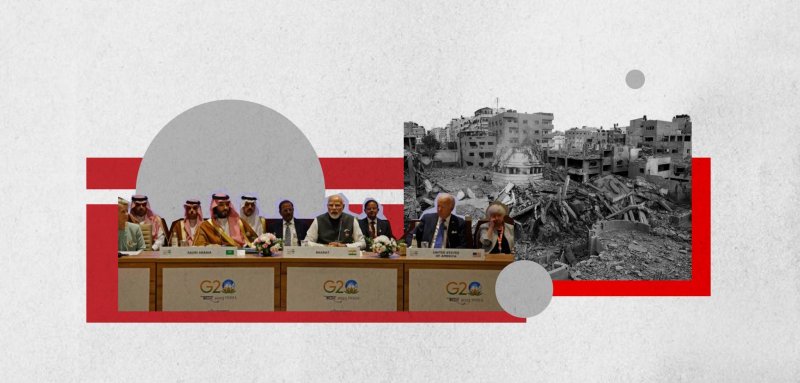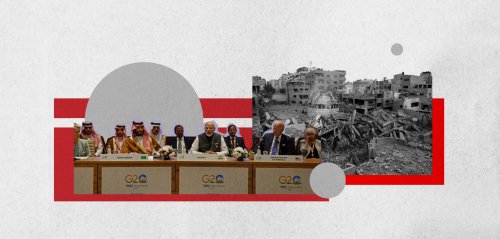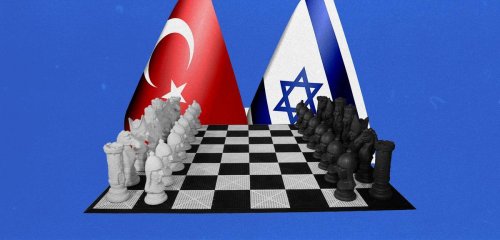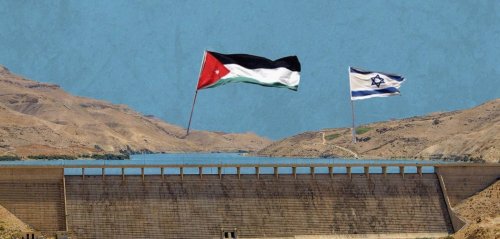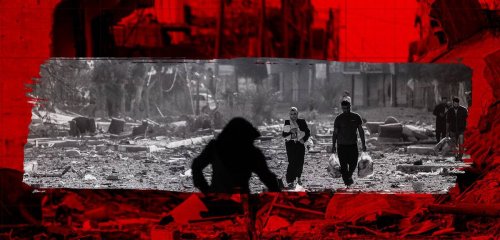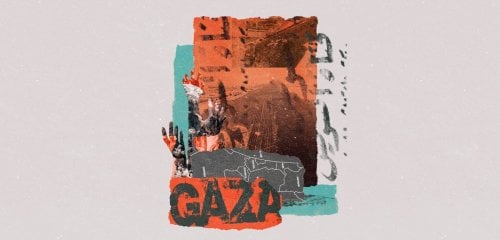The Israeli war on Gaza has brought to surface a host of other regional issues, notably the India-Middle East-Europe Economic Corridor (IMEC). US Deputy National Security Advisor Jon Finer describes this corridor as being in line with US President Joe Biden's efforts to "turn the temperature down on turbulence and insecurity" while fostering an increased flow of energy and communication.
The Corridor was officially announced during the recent G20 Summit in New Delhi. Leaders from the United States, India, Saudi Arabia, the United Arab Emirates, France, Germany, and Italy signed a memorandum of understanding, and agreed to reconvene sixty days later to establish the practical foundations for the project.
According to the Financial Times, the Corridor could benefit the United States by countering Beijing’s growing influence in the region.
It is an alternative to the Chinese Belt and Road Initiative, perceived by the West as a geo-political project with an economic-development cover, intended to extend Chinese influence across Asia, Africa, and Europe.
On the other hand, the US-led project aims to “integrate Israel into the Arab region, enhance India's position in confronting China, and solidify the Middle East as an American zone of influence in the face of China's attempts to penetrate it,” according to the Arab Center for Research and Policy Studies.
Despite the Israeli war on Gaza highlighting the security challenges faced by both projects, it has specifically brought to light certain security concerns of the IMEC.
The Israeli war on Gaza has underscored the security concerns facing the India-Middle East-Europe Corridor, which is proposed as an alternative to China's Belt and Road Initiative as part of the US's geopolitical competition with China
The abrupt withdrawal of US forces from Afghanistan has fueled speculation about its intention to thwart China’s partnerships with neighboring countries, and completely sabotage the Belt and Road Initiative. Afghanistan presents the shortest route connecting Central Asia, South Asia and the Middle East via the shortest route, and is therefore deeply significant for China.
Washington has also shown support for the separation of the Uyghurs in Xinjiang, and backs an independent Balochistan, the Pakistani southwestern province where the port of Gwadar is located. These moves raise further questions about the US’ geopolitical strategy.
Gwadar, a key point of the China-Pakistan Economic Corridor and the Belt and Road Initiative, is strategically vital as it significantly shortens the route from 12,000 km at sea, to under 3,000 km over land, as highlighted by the QNB Group.
The Russia Ukraine conflict has disrupted access to the Eurasian Land Bridge, one of six pathways for the Chinese initiative, which extends from western China to western Russia. This Middle Corridor spans a region marred by tension and conflict, including the regional conflict over Nagorno-Karabakh.
Thorns in the "Belt and Road" pathway
Marking a milestone, Chinese and Pakistani navy forces conducted their first joint maritime patrol in the northern Arabian Sea, a practical move aimed at securing the China-Pakistan Economic Corridor. According to Chinese military expert Song Zhongping, “The Arabian Sea is crucial for both China and Pakistan in terms of cargo and energy transportation... It is important for our two countries to protect this marine corridor from security threats.” Future joint maritime patrols are expected to become routine.
Shakeel Ramay, head of the Asian Institute of Eco-civilization, Research and Development (AIERD) in Islamabad, points out the opposition that Pakistan and China have faced from the US since they signed the joint agreement. Ramay points out certain pressures imposed on Pakistan, from being placed on certain countries’ gray lists for supporting terrorism and money laundering, to pressures from the IMF. Moreover, the IMF stipulated that energy agreements made with China in regards to the Corridor must be reviewed, raising suspicions of institutional bias towards China.
Despite the challenges faced by the Belt and Road Initiative, it is much further developed than the India-Middle East-Europe Corridor. The former is a comprehensive strategic project linking several continents through road, rail, and maritime networks.
Ahmed Dahshan, a researcher in History, Russian and Eurasian affairs, and International Relations, spoke with Raseef22. Dahshan underscored that “it's a project with alternatives. For transport to Europe, it has the China-Kazakhstan-Russia-Belarus route and a direct route from China to Russia through Siberia to Belarus and Europe. Additionally, there's the 'Middle Corridor' via China-Kazakhstan-Azerbaijan-Georgia-Turkey, reaching Britain. When the route to Europe via Russia-Belarus is disrupted, Beijing turns to the 'Middle Corridor' via Kazakhstan and the South Caucasus.”
Referring to the precursor of the Belt and Road, announced in 2013, Dahshan explains, “it is a project adopted by the Chinese state itself, and it has drawn scenarios capable of networking interests with all parties. Therefore, the project is central and carried out by the Chinese government in terms of planning, financing, managing relationships with partners, spending money, and building the infrastructure with flexibility to provide some benefits to the countries through which the project passes.”
Internal and international conflicts, such as border tension between Tajikistan and Kyrgyzstan, present significant hurdles for the Chinese initiative. The China-Pakistan Economic Corridor, aimed at reducing Chinese dependence on the the Strait of Malacca (a waterway between Peninsular Malaysia and the Indonesian island of Sumatra, through which more than 60% of Chinese energy imports pass), crosses northern Pakistan before reaching China's Xinjiang region. The northern Pakistani region faces threats from the Taliban, especially in refugee camps, making secure passage crucial to prevent terrorist interference. It also traverses the Pakistan-governed Kashmir, an area disputed with India, causing friction and the potential of escalated tension, according to Shahdi Al-Mansour.
The ongoing war on Gaza underscores that without a just and comprehensive resolution to the Palestinian issue, the Corridor cannot be relied on. A route for energy and goods transport to Europe, it would rely on roads in a region that could explode at any moment
A route marred by tension: Complications to the IMEC corridor
IMEC faces critical challenges and obstacles, notably navigating the complex political geography of a broad region with many countries, each with its distinct political dynamics, interests and past tensions.
Academic and Geopolitical Monitor analyst Mohamed ELDoh notes that this hinders the development of smooth connection between the countries concerned. The Corridor’s route crosses areas of conflicts and rivalries, such as that between India and Pakistan, Saudi and Iran and the ongoing conflicts in Syria and Yemen. Additionally, the threat to Israel posed by Iranian militias in Syria and Lebanon add further complications and hinder cooperation and the implementation of regional connectivity projects.
The glaring differences in the politics of the involved countries might pose challenges. Differing political ideologies and values, and disparities among stakeholders could hinder effective progress. Trade competition seeking influence in Corridor regions present geopolitical risks to the countries involved, as the conflicting interests among commercial and trading powers may lead to power struggles and potential resistance during the actual execution of the project.
Multiplicity of stakeholders is a weakness for the project. Diverging interests among stakeholders creates a conflict of interests between the parties, despite their initial collaboration. Ahmed Dahshan notes that “Washington lacks a stable and fixed strategy, changing policies drastically with each administration. The United States has become something akin to a Third World country, with its policies changing sharply at times when its President changes.” At the same time, Dahshan questions the United States in the face of stronger or more ambitious global actors, and its ability to manage contradictions and relations with multiple parties, many now more powerful with broader aspirations than in the past.
The project also has a single route linking India to some Middle Eastern countries, en route to Europe, conflicting with the interests of several regional powers. It clashes with Iranian and Turkish interests. Dahshan references Turkish Foreign Minister Hakan Fidan, whose statement outlines that any corridor connecting Asia to the Middle East and Europe will not be successful without crossing Turkey. Moreover, “the project links Jordan with Israel, two countries in a state of extreme tension, and perhaps confrontation, due to Israel's desire to turn Jordan into an alternative homeland for Palestinians.”
The ongoing war in Gaza underscores that without a just and comprehensive resolution to the Palestinian issue, this project cannot be relied on. As a route for energy and goods transport to Europe, the Corridor would be dependent on roads in a region that could explode at any moment.
Dahshan explains, “Unlike the Belt and Road Initiative, the American project does not offer alternatives or incentives for the project countries or those affected by it. The project is merely a message from the US to China before engaging in negotiations, that it has the capability to create alternatives to harm and pressure China. In turn, Gulf countries, particularly Saudi Arabia, aim to signal Israel of the potential benefits of Saudi-Israeli normalization through their approval of the project.” Dahshan notes strong Gulf interests with China, which are realistic and not dependent on the future, unlike the IMEC.
The US has blocked India from investing in the Iranian port of Chabahar, which connects India to Europe. The US's proposed IMEC corridor practically eliminates any Iranian ambition to become a transit point on the global trade line between Asia and Europe
India vs. China; A distorted dynamic
Washington deliberately blocks Iranian attempts at rapprochement with India, keeping India from investing in the Iranian port of Chabahar, a key hub for the North-South corridor connecting India and Europe through Iran. The India-Middle East-Europe corridor practically eliminates Iranian ambition to become a major transit point on the global trade line between Asia and Europe.
According to Dahshan, comparisons between India and China are far-fetched. He points out the vast internal contradictions in India, a highly traditional country that still faces slavery, has a high poverty rate, faces social and religious segregation and is governed by an extreme right-wing national government. India's broken fiber cannot compare to Chinese infrastructure. Moreover, India-Pakistan tensions pose severe security concerns.
According to Geopolitical Monitor, Iran's geographic location, at the crossroads of Asia and the Middle East, and in strategic proximity to the Strait of Hormuz, the primary route connecting India to the UAE in the IMEC, also poses a clear threat. If tensions flare in Iran, or if support of regional armed groups raises international concerns, the safety and security of the corridor is compromised. Considering Iran's history, there is a threat of terrorist attacks targeting vital infrastructure along the Corridor.
Raseef22 is a not for profit entity. Our focus is on quality journalism. Every contribution to the NasRaseef membership goes directly towards journalism production. We stand independent, not accepting corporate sponsorships, sponsored content or political funding.
Support our mission to keep Raseef22 available to all readers by clicking here!
Interested in writing with us? Check our pitch process here!
